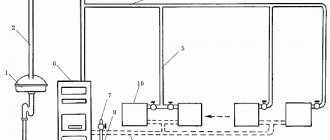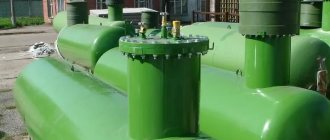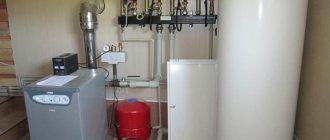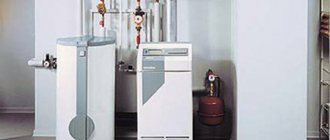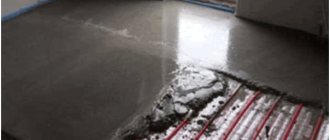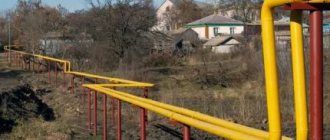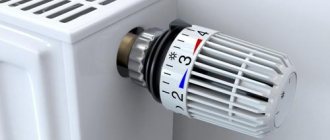Modern economical technologies
This technology includes a heat pump.
With the help of earthly resources, it is capable of producing at least 4 times more energy than it consumes itself. If you need a boiler for your home with a power of 20 kW, then a heat pump with a power of only 5 kW will be suitable for heating. The heat pump runs on electricity. The pump also costs 3-4 times more than a first-class gas boiler with high efficiency. Solar collectors can be used for heating. There is no energy consumption required at all. When properly installed, solar collectors can heat heated floors and provide you with the necessary amount of hot water. But again, it all comes down to finances.
Our future lies in these technologies. The moment will come when both a heat pump and a solar collector will become available to everyone.
As a result, we get that using a warm floor + temperature control + a heat pump (or collector) we can get truly the most economical home heating.
If you are looking far ahead and are confident that you can afford such expenses, then you definitely will not regret having all this installed at home.
About the most profitable home heating system
Now it remains to find out which heating system for a private home is the most economical. In this category, water heated floors win by a decent margin. And that's why:
- Heated floors are at least 30% more economical than radiators (subject to special conditions for temperature control and boiler installation for low-temperature systems);
- Warm floors heat from bottom to top, while radiators heat the ceiling first;
- Heated floors operate at low temperatures. The high limit is 45 degrees.
- Warm floors can be heated with anything.
That's exactly what they say all over the Internet. In fact, all modern systems are approximately the same in terms of efficiency. It doesn't matter what you install, it's important how accurately you adjust it all. The more accurately the heating system is adjusted, the more economically it operates.
The most important point by which savings are achieved on heated floors is thermal insulation. Manufacturers recommend using polystyrene foam with a density of 35, a thickness of 10 cm on the first floor and 5 cm on subsequent ones.
In practice, 5 cm on the first floor is quite enough. Unless, of course, you live in a region with extreme cold.
You can see what a heated floor looks like in our video:
The second point by which you can get the most economical home heating is temperature control. By installing room thermostats with sulfur actuators on the collector and a mixing module, you can save up to 50% compared to radiator heating.
You can make the adjustment simpler, and the underfloor heating system as a whole.
Types of heating systems
There are several ways to organize electric heating in your home. Each of them has its own advantages and disadvantages. Some are cheaper at the purchase stage, and some save significantly during operation. Let's look at what features each method has:
Installation of an electric boiler designed to heat water passing through the pipes of the heating system. Perhaps the most well-known method, but at the same time far from the most effective today. Manufacturers claim that current models have become much more productive and now consume 80% less energy, but this is a controversial issue. Manually switching the boiler on and off, of course, is impractical, and automatic switching on and off at a given interval does not take into account the temperature conditions of day and night. A more or less economical option is to install thermostats and corresponding automation to switch on depending on the temperature in the rooms, but this is difficult from an installation point of view and very expensive. Reduced power models with equal performance are also nothing more than advertising. Such a boiler most likely will not have enough “power” to heat a large private house. Infrared panels. This is not just a way to heat rooms, but a fundamentally excellent technology. The point is not in heating the air (which has very low efficiency), but in influencing objects located in the room. Under the light of IR lamps, floors and furniture heat up and begin to emit heat themselves. The fundamental difference is that the traditional “radiator” method of heating rooms actually heats the ceiling (warm air from the radiator rises), while the floors remain cold. With infrared heating the opposite is true. The light is directed downwards, which means the warmest place is the floor. Supplement the system with thermostats - and economical heating of a country house, private house or garage is ready. And the opinion about the dangers of infrared radiation on humans is nothing more than a myth. The main thing is not to stay under the lamp for a long time, and nothing dangerous will happen. Use of convectors. According to manufacturers, this is the most effective way to heat rooms, which combines high performance and economical energy consumption. Both of these statements are the subject of a long debate, since the technology is based on the same “radiator” principle, and many individual characteristics must be taken into account when heating a house. The main difference is the significant ease of installation and operation and lower price
An important advantage of convectors is fire safety, which is very important when heating a country or private house made of wood. Convectors allow you to install them sequentially from room to room, are compact and pleasant to look at, and are also protected from power supply surges.
Increasing the efficiency of your heating system
To increase the efficiency of heating a home, it is also possible and necessary to introduce various technologies that reduce fuel consumption into the heating system. There are a huge number of ways to route pipelines from the boiler to the radiators.
Some of them are cheaper to implement, while others are the most economical in terms of reducing losses during transportation of coolant to the batteries.
The efficiency of a home heating system depends on the correctly selected boiler power, pipe layout and even the pipeline material
There are heating equipment of different designs and various additional equipment that can increase the efficiency of the entire system by 10–15% or more. But here you should carefully weigh the pros and cons. In some cases, the costs at the initial stage may not be recouped later.
There is no need to chase the “most economical” and “most effective” options. Often these are just advertising slogans and nothing more.
Method #1: pipe routing and “warm floor”
The most economical piping layout is radial heating with a central collector. When using it, each radiator receives the same volume of coolant.
Moreover, it is possible for each battery to adjust the amount of heat supplied individually. Extra waste of thermal energy when transporting heated water through heating pipes with such wiring is practically eliminated.
The boiler manifold circuit is most effective in terms of balancing the hydraulic resistance of individual circuits and controllability of heat flows (+)
Almost always, with collector wiring, the heating system has to be supplemented with a circulation pump. Thanks to it, the difference in water temperatures at the inlet and outlet of the network is significantly reduced.
As a result, the controllability of coolant heating and the efficiency of the entire system are increased. Less fuel has to be burned in the boiler, which results in direct savings on fuel.
The beam (collector) option is the most economical to operate. However, due to the long length of pipelines, it is also the most expensive to implement.
To maximize the efficiency of your heating system, you can simply abandon radiators and replace them with “warm floor” pipes
The heat from conventional radiators first rises to the ceiling, and only then, due to convection, spreads throughout the room. As a result, the hottest air ends up near the ceiling. And to prevent your feet from freezing on the floor in the cold outside the window, you have to open the radiators all the way. And this again means additional costs for heat generation.
A water heated floor system is the most economical way to heat residential premises. In this case, the warmest air is concentrated below at the level of a person’s feet. At the same time, heat consumption is reduced, and the most comfortable conditions for people are created in the room.
Method #2: the most efficient boilers
The highest efficiency is found in pyrolysis and condensation boilers. It is difficult to find more economical heating equipment in heating equipment stores. The first option uses wood as fuel, and the second uses gas. In terms of efficiency, they outperform all other analogues using any flammable coolant.
A pyrolysis boiler differs from a conventional wood-burning boiler in the presence of a second firebox and in the fact that in fact it is not wood as such that burns there, but the gas obtained as a result of pyrolysis.
First, the logs smolder in it at high temperatures and limited air supply. And only then the resulting gases burn in the main chamber, releasing heat.
Compared to its standard wood-burning counterpart, a pyrolysis boiler has higher efficiency (30–40%) and requires less attention. The interval between loading firewood, depending on the capacity of the firebox, reaches 10–16 hours.
Savings here are achieved due to absolutely complete combustion of fuel and a minimum of heat release with combustion products into the chimney.
A gas condensing boiler is even more economical - it takes thermal energy not only from the burned methane, but also from the products of its combustion
Taking into account the collection of additional heat, the final efficiency of such a boiler reaches 105–110%. Here, the energy of both the burned gas and that obtained as a result of the condensation of water vapor occurring in the second chamber is taken into account.
Method #3: choosing a heat accumulator
Another fairly effective way to save on heating is to connect a heat accumulator to a solid fuel boiler. The latter first accumulates heat in itself, and then gradually releases it to the batteries.
In this case, it is not necessary to forcibly limit the power of the coolant heating equipment, simply throwing out the heat into the chimney pipe.
The heat accumulator allows you to reduce bills for solid fuel used by 10–30%; all the heat generated in the boiler goes to the home heating system (+)
If electricity is supplied to the cottage at different rates day and night, then the heat accumulator can also be included in a system with an electric boiler. In this case, it will accumulate heat at night, when electricity is cheaper.
Comparative analysis based on other criteria
In addition to the questions: the cheaper it is to heat a house, fuel consumption and efficiency, various heat generation options can be compared according to other parameters:
- From an environmental point of view, it is better to use equipment that runs on electricity. Then there is a gas boiler and combined gas-electricity systems.
- Electric convectors and infrared emitters have advantages in terms of complexity and cost of maintenance. The most demanding in terms of this parameter will be solid fuel systems, which require daily cleaning and loading.
- In terms of installation complexity, hybrid systems rank first, for example, solar collectors - gas boiler. The easiest to install is electrical equipment, followed by solid fuel boilers. Gas devices are installed, tested, and serviced only by special organizations and require a large number of permits.
- According to safety criteria, any heating system can lead to unpleasant consequences if used incorrectly. Possible electric shocks, fires, and gas explosions.
Nuances of operation
Heating systems have their own operating characteristics depending on the quality of installation and type of equipment.
Systems of the same type work differently because:
- fuel of a different quality is used;
- coolant parameters differ;
- a local zone of low pressure has formed in the expansion tank;
- air is sucked into the circuit due to a leak;
- air diffusion occurs through the surface of pipes made of plastic;
- During the installation of the pipeline, plugs were allowed to form, for example, when soldering pipes.
About fuel storage
To prepare a supply of firewood for the entire season, you will need a room protected from moisture. Coal, briquettes and pellets also require special storage conditions.
To contain liquid fuels, you will need a plastic or metal container, which should not be in the basement.
Equipment service
Primary and additional heating in a cottage or private house require periodic inspection, repair and replacement of components. The following signs indicate the need for work:
- Coolant is leaking from radiators and pipes;
- seething or noise is heard in the system;
- uneven heating in different rooms and floors;
- The system functions worse than at startup.
Possible causes of problems:
- design errors;
- the tightness of the connections is broken;
- Radiators are installed incorrectly;
- air pockets interfere with coolant circulation;
- equipment was installed in bad faith;
- due to incorrect connections, the system was unbalanced;
- use of low-quality components.
Boiler unit to heat the house
When choosing what is more profitable to heat a house, we must not forget about the costs of installing a heating unit
It is not always important how cheap the energy carrier is, since the equipment for its use (or generation, if we are talking about solar energy, etc.) can be expensive. We will give an approximate price range for different types of heating equipment to determine which one is more profitable to choose
Brick oven with stove. 20-100 t.r. and more, depending on the size, type, complexity of the design, the presence of tiled cladding, etc. A well-made stove is ideal for a wooden house; it can last for several decades.
Liquid fuel boiler. The cost of the unit is 25-180 thousand rubles. Many models are suitable if you plan to connect a house heated with diesel fuel to a gas main - the boiler just needs to replace the burner and no new equipment will be required.
Solid fuel boilers. 20-400 t.r. An inexpensive option will require frequent refilling of fuel. Long-burning boilers are included in the middle price category. Automated units require large investments during the installation phase.
Choosing a boiler unit
Electric boilers. 15-100 t.r. depending on the power of the model. If the region has a cheap nightly electricity tariff, you can partially reduce heating costs by installing a heat accumulator complete with an electric boiler
In addition, when choosing how to heat a house if there is no gas, you can pay attention to other heat sources that run on electricity: infrared heaters, fan heaters, film heated floors, air heating systems, etc.
Solar collectors. 15-60 tr. – cost of flat devices, about 80 thousand rubles. – vacuum. The energy of the sun is inexhaustible, but even in areas with a large number of sunny days a year, solar collectors serve only as an additional source of thermal energy for heating or preparing water in the hot water supply system.
Heat pumps. 200-1500 t.r. depending on the complexity of the system. A heat pump extracts thermal energy from the environment. Its operation requires starting energy; on average, to deliver 10 kW of thermal energy, it spends 3 kW of electricity - this is high efficiency. But the heat pump is also not universal, since it is able to function stably only at an air temperature of at least -15 degrees, and completely loses its functionality at -30 degrees. In temperate regions, a heat pump would provide the cheapest heating if not for the significant initial investment.
Results
Everyone selects the most economical heating based on specific conditions; there is no universal advice on this matter. A good option is an electric boiler in combination with any other unit, primarily solid fuel. A heat accumulator to which you can connect several different heat sources, including a solar collector, is a real opportunity to spend a minimum of money on heating.
In addition, we should not forget about high-quality insulation of the house. You can save on fuel only if heat loss is kept to a minimum.
Video on the topic:
How to heat your house without going broke?
Electric boiler
An electric boiler for heating a private home is, first of all, reliability, mobility, rationality and concern for health. It is easy to install and does not require additional boiler room. With its light weight and mobility, a boiler of this type can always be reinstalled in the places where it is needed. The device fully complies with fire safety standards. When choosing an electric boiler, pay attention to power. The larger it is, the larger the area you will heat. In addition, there will always be hot water in the house.
Infrared heating
The main advantage is that it does not dry out the air. Electricity consumption is much less. But in terms of heating, they are designed for certain squares or zones. Infrared heating of a country house is interesting when guests or the owner of the house and his family come on vacation and it is necessary to quickly heat the air and surrounding objects. For large houses with high ceilings, pay attention to medium-wave heaters, since long-wave heaters do not have enough power to provide the required temperature. If you give preference to stationary infrared ceiling-type heaters, they can completely replace gas heating, plus they do not take up much space. But this option is interesting only when someone plans to live in a private house in winter.
Monolithic quartz heater, electrical panel
Heating a house with electric panels is not an easy task, but not too difficult either. For large rooms, a system of several monolithic quartz heaters is used, which must be connected in parallel. They work using quartz. Also, special heating elements are built into the electrical panel, usually made of chromium and nickel. This allows you to quickly heat up the wall heater and quickly warm up the rooms, even if the owners have not been in the house for a long time. After the monolithic quartz heater is turned off, the internal parts retain heat for a long time and maintain the air temperature quite comfortable. The device does not require special care, but there is no need to expose it to layers of dust.
Air conditioning and split system
Should you heat your house in winter? When you have an air conditioner, it is much easier to find the answer to this question, because you always have an irreplaceable source of heat at hand in cold weather and coolness in summer. If you need to get 2 in 1 and not buy fans later, then this device will solve all the problems at once. Choose split system air conditioners to get:
- virtually silent heating in winter and cooling in summer;
- device with high power and low power consumption;
- heater out of the reach of children;
- climate control system;
- easy control from anywhere in the room;
- built-in filters and capacitors.
Solid fuel
Heating in winter and in cool times using solid fuel directly depends on where the heating is planned. What can be used for a garage will not be suitable for a home, for example. It is always necessary to take into account the needs of specific premises, not forgetting that heating should be as economical, safe and efficient as possible. Let's look at what heating options with solid fuel are available for a country house in winter. Please note right away that in addition to the device itself, you will also need to purchase fuel for heating:
- coal;
- firewood;
- pallets;
- fuel briquettes;
- wood chips;
- sawdust;
- peat.
To refuse gas completely or to install pipes to supply blue fuel is a purely individual question. If you think through the options and combinations of heating with electric or solid fuel, then gas may not be needed at all.
Solid fuel boiler
It is selected depending on the output power in relation to the volume of the house. The greater the output, the more heat. Requires a specially allocated space in the house, but does not require electricity. Raw materials are purchased independently. The emphasis must be placed depending on what result is needed. Wet raw materials lead to poor heating, so try to keep water or other moisture away. Autonomy and lack of dependence on gas supply are clear advantages of a solid fuel boiler, which distinguish it from other participants when choosing heating devices.
Metal stove (potbelly stove, Buleryan stove with water circuit)
The choice of a metal stove is influenced by the size of the house and the number of heated rooms. For spacious houses, a long-burning stove with high heat output is required. For smaller areas, standard hand-made metal stoves are also suitable. At the stage of preparatory work before installing a potbelly stove, it should be taken into account that the wall must have heat-resistant properties. Of course, the stove can be placed in the middle of the kitchen, which will simply not be convenient. Therefore, it is good to first protect the wall with heat-resistant materials, and lay out the screen using brick or ceramic tiles. In the case of Buleryan heating, the process occurs due to air convection, which, in addition to general heating, creates the effect of a warm floor. The air below enters the furnace tubes and warms up. Therefore, the closer it is to the floor, the more effective it is. In general, heating with a stove is very economical and easy to install, but you need to go to it at least 3-5 times a day to refuel.
Brick oven
Brick ovens come in different varieties. The stove can have an exclusively hob, a heating and cooking option, or be used only for heating premises. And although its installation requires more effort than in the case of electricity, it is still impossible to completely warm up the entire house with electrical appliances in severe frosts. But with a brick oven, if installed correctly, yes. To install it, it is best to seek the help of an engineer or someone who understands this process in order to correctly develop a design in accordance with the style of the house, buy all the necessary elements for constructing the stove and get the result without risk to health.
Pipes for heating system
The choice of material for pipes depends on the type of heating system and the financial capabilities of the developer. In case of force majeure, the possibility of alternative heating of premises should be taken into account.
Today the following types of pipes are used:
- Steel
- Galvanized
- Stainless
- Copper
- Polymer
The disadvantage of steel pipes is low corrosion resistance. When installing stainless and galvanized pipes, it is advisable to use threaded connections.
Copper ones are used in exclusive projects. The advantages of copper pipes are reliability and high temperature resistance. Copper can also easily withstand high coolant pressure. The pipes are connected by high-temperature soldering using silver-containing solder.
Polymer (polypropylene, metal-plastic) are durable and resistant to corrosion. There are no deposits on the inner walls of the pipe. The pipeline is installed using threaded connections.
Important: metal-plastic pipes have a high coefficient of thermal expansion, so defrosting the system leads to irreversible damage. Metal-plastic cannot be bent at an acute angle: aluminum reinforcement may break
Water heating
This type of heating belongs to the category of the simplest and most reliable. The operating principle of water heating is based on heating water using a boiler and its subsequent distribution to room radiators thanks to a piping system.
The use of a circulation pump ensures constant circulation of water in this closed system. The coolant in a water heating system is usually water or antifreeze, and the boiler can operate on coal, wood, natural gas, kerosene and other types of fuel.
Water heating includes the following main elements: boiler, pipelines, batteries, expansion tank, circulation pump, pressure gauges, shut-off valves, automatic air vents, safety valves.
Pipelines used for water heating can be made of various materials:
- Steel.
- Copper.
- Polymer materials.
Steel pipelines, unlike stainless or galvanized ones, are characterized by low corrosion resistance. Copper pipelines are highly reliable and can withstand high temperatures and pressures.
Pipelines made of polymer materials are quite durable, eliminate the formation of sediment on internal surfaces, and are highly resistant to corrosion.
Their disadvantage is the presence of a large coefficient of thermal expansion, which contributes to the formation of leaks.
Thus, the most efficient water heating of a cottage or private house can be achieved using copper pipelines. This opinion is shared by the vast majority of experts.
The only drawback of pipelines made of copper is their comparative high cost, which is compensated by their absolute reliability and ability to last for several generations.
Water heating scheme. Click to enlarge.
Indoor piping can be done using single-pipe, double-pipe or manifold.
Single-pipe wiring does not allow full control of the performance of the entire system due to the impossibility of blocking access of the coolant to one of the radiators.
The option using a two-pipe system is the most efficient (for individual houses) heating, allowing you to freely adjust the temperature inside each room.
This type of wiring involves supplying cold and hot pipelines to each radiator. The distribution of pipelines can be carried out in a star-shape or in the form of a “loop”.
Manifold wiring involves connecting supply and return pipelines to each heating device from a common manifold.
Manifold systems are distinguished by a high degree of versatility due to ease of installation and adjustment, the ability to replace damaged sections of pipelines (without destroying the floor structure).
Which heating is better (single-circuit, double-circuit or collector) for a country house? The answer is obvious - two-pipe and collector.
Wood stove heating
If the house is built far from gas mains or you don’t want to pay for expensive coolant, you can install a wood heating system. This option is ideal from an environmental point of view and does not harm the health of residents. How does a wood heating stove work?
The operating principle of this design is simple and clear. You buy a stove, put wood in it, and light it. The wood burns and heats the stove equipment. The stove gives off heat and the air in the room warms up.
Despite the seemingly primitive design, this heating option has a number of advantages:
- the oven heats up quickly;
- there is no need to buy and install pipes, radiators, pumps;
- the design is reliable, designed for long-term use, and is difficult to damage;
- Firewood can be purchased inexpensively.
Modern heating stoves bear little resemblance to the well-known potbelly stoves. The design of the furnace is designed so that the installation gives off a lot of heat and can operate for a long time on one load.
The structure of a boiler for wood.
A boiler can be integrated into a wood heating system. When choosing a boiler, it is better to choose a pyrolysis type design. Heat will be generated as a result of combustion of pyrolysis gases. This type of boiler equipment can function without electricity.
Now about the disadvantages of this type of heating of buildings:
the furnace installation is quite large, you will have to think about where to install it; the equipment weighs a lot, so you won’t be able to install the stove yourself; near the house you will have to provide a covered room for firewood; it is important that the supply of wood is sufficient for the heating period; combustion products if the stove device is used incorrectly can be hazardous to health; when heating with wood, you will have to provide a chimney; the stove will heat the room unevenly.
Stove heating
This method of heating a home can easily be considered one of the most ancient. Having originated many centuries ago, stove heating is still very relevant. The reason is simple - it helps to heat the house quite quickly, and firewood - the main fuel used in stoves - is not uncommon. On the other hand, it is quite difficult today to find a good stove maker who can build a high-quality and, importantly, safe stove.
Heating a private house with a stove
After all, often mistakes made during the construction of the furnace became the cause of irreparable disaster. Many people say that the main disadvantage of the stove is that it heats the house unevenly, especially if it consists of 3-4 rooms. A stove heating system in a wooden house can be a good solution for a country house, which will be visited quite rarely during the cold season.
Heating a country house with liquefied gas
If there is no gas main nearby, you can heat the house with liquefied gas (a mixture of propane and butane).
It's not much more expensive. Gas has no expiration date. The main problem is the supply and storage of fuel. Cylinders are used to heat small houses; for cottages with a significant living area (for example, for two-story houses made of foam blocks), an underground storage tank (gas holder) is installed. The heating system is connected to it. Heating cylinders have a volume of 30-50 liters. The gas container is installed outside, in a special cabinet near the wall of the house. The pipe connecting the cylinder to the boiler should not have threaded connections or sharp corners.
Rules for using gas cylinders:
- It is prohibited to gasify basements and basements
- It is necessary to provide free access to the tank from all sides
- Do not expose the gas container to heat or direct sunlight.
- It is not allowed to operate tanks with damaged housings or corrosion.
- The distance from the cylinder to the boiler must be at least 1 m
For a continuous supply of fuel, it is best to install several cylinders. They are connected through a special ramp that has a flexible connection, a gas pressure measurement sensor and a safety valve. If the cylinder heats up, the valve releases excess gas, thereby reducing the pressure inside the cylinder.
Gas boilers operating on natural and liquefied gas have no fundamental differences. The only thing is that when connecting a cylinder, due to the high calorific value of liquefied gas, it is necessary to install a nozzle of a smaller diameter.
Any houses for permanent residence, whether made of foam blocks or frame houses. need a heating system. The comfort of living depends on how well the heating system and other utilities are implemented.
Even if you do not plan to build a house for permanent residence, but only for seasonal residence, you still need a toilet, for example, a peat one. And for this, in turn, a cesspool is needed. Read about the process of constructing a peat toilet for your dacha in this article. about the construction of a cesspool - here.
Finally. Installation of gas heating is best left to specialists. Unprofessional installation of equipment is fraught with more than just breakdowns. The health and lives of users are put at risk. A properly installed system is convenient, safe, and economical, because the homeowner can independently regulate the temperature of radiators and hot water.
Comparative analysis based on other criteria
In addition to the purely economic calculation of the cost of heating, there are other factors that influence the choice of energy source. For example, it is difficult for an elderly pensioner to chop and carry firewood to the boiler room. Some people don’t like the smell of diesel fuel or the dirt from coal, while others don’t have the opportunity to store a supply of pellets or briquettes. That is, choosing fuel for heating only from the point of view of economy is wrong. Additional criteria need to be taken into account:
- comfort during use;
- possibility of storage;
- frequency and cost of service.
Nuances of operation
It is most convenient to use electricity for heating, although it is difficult to classify it as an economical energy source. The electric boiler does not require supervision, the system is fully automated. The unit is easy to control remotely, and the boiler room is quiet, clean and free of unpleasant odors. An important point: the electrical heating installation does not require a chimney, which greatly simplifies and reduces the cost of installation.
In addition to the high price, electric heating has another disadvantage. Not every private home has sufficient electrical power or a limit has been set that does not allow the use of energy for heating. And connecting units with a power of over 6 kW requires a 3-phase input with a voltage of 380 V.
It is almost as comfortable to operate boilers that burn natural and liquefied gas. But they require a chimney and good ventilation of the furnace room. Burning diesel and used oil is no longer so comfortable, since an odor inevitably appears and periodic replenishment of the fuel container is required. In this respect, a diesel heat generator is similar to a pellet heat generator, but the latter benefits from the absence of odors and dirt.
The champion in inconvenience is the wood and coal boiler, which requires constant attention and physical exercise. With the most economical method of heating with wood, the smell of combustion and dust mixed with dirt in the boiler room cannot be avoided (especially for coal). An exception is an automatic coal boiler, which operates on the principle of a pellet boiler, but it also requires periodic replenishment of the bunker.
Automatic boilers: pellet (right) and coal (left)
About fuel storage
The nuances of warehousing and storage are easier to identify in the list:
- The electric and gas heating system of a private house operates from external sources; no storage is needed.
- For reliable operation of any solid fuel boilers, you need a supply of fuel; accordingly, it is necessary to organize its storage. You will have to make a firewood shed under a canopy or a warehouse in a barn.
- The supply of diesel fuel and waste also needs to be stored somewhere and, preferably, outside the residential building. It is necessary to purchase and install a container of sufficient volume.
- The most difficult thing is to organize storage with autonomous heating using liquefied gas as an alternative to natural gas. The cost of an underground gas tank and its installation will quickly make you forget about economical heating of your home.
Not everyone can afford to install a gas tank, and constantly carrying cylinders to refuel is hard work.
There is another, cheaper way to store liquefied gas - in cylinders. But “thanks to” frequent replacement and refilling of cylinders, comfort when operating a propane boiler is equal to exercises with firewood when loading a solid fuel heat generator.
Equipment service
Electric heating systems require virtually no maintenance (check and clean once every 2 years). If it were not for the draconian daily tariff, then with the help of electricity it would be possible to organize a “economical smart home” system. Gas boilers will have to be serviced more often; they require annual preventive cleaning of the heat exchanger and chimney. But here you can save money if you clean the unit yourself, as described in this article.
Due to the low quality of diesel fuel, diesel heat generators will need to be cleaned as they become dirty, which can happen several times a season. The same applies to waste oil boilers, and the cleaning process is very dirty. Faced with problems like this in the middle of winter, you'll think twice about whether you need energy-efficient heating while working.
It is advisable to clean the smoke pipes with the firebox of a boiler using wood and pellets once a week, and the ash pan - daily
When working with wet wood from the combustion chamber, it is important to remove soot and tar more often before they become completely stuck.
Vodyanoye
Water heating is a closed system through which hot water continuously circulates. The boiler acts as a heating element. Radiators are installed in each room. From the boiler, water circulates through pipes along the circuit and, passing through radiators, gives off heat.
The benefits of a water system depend on the type of fuel used by the boilers. If there is a gas main nearby, then it is wiser to purchase a gas boiler. Gas fuel is considered the most economical. However, such structures require regular maintenance by special services. For non-gasified areas, it is better to purchase solid fuel boilers.
It is not advisable to use liquid fuel for the boiler, since it is expensive and will require the construction of a special tank in the ground to store it.
Fuel consumption
Example No. 1. Calculation of fuel consumption in a water heating system: gas will act as fuel, since it is the most common. For the calculation, you will need the power of the unit and the area of the heated housing. The boiler power for a private building is determined based on the proportion: 1 kW per 10 m². For a room of 100 m² you will need a 10 kW boiler.
To calculate fuel consumption, it is necessary to multiply the boiler power by 24 hours and by 30 days. As a result, we get 7200 kW/hour. Since the unit does not always operate at full capacity, this number must be divided by 2. Monthly fuel consumption is approximately 3600 kW/hour. The heating season lasts approximately 7 months. Fuel consumption during the heating period is 3600*7 = 25200 kW/hour. Considering that 1 m³ of fuel produces 10 kW/hour of energy, we get: 25200/10 = 2520 m³.
Let’s convert the resulting value into a monetary equivalent: the national average cost of gas per 1 m³ is 4.97 rubles. Accordingly, gas heating for the year: 4.97 * 2520 = 12524.40 rubles.
Advantages and disadvantages
The main advantages of a water heating system are:
- prompt heating of even a large room;
- quiet operation;
- ensuring the same temperature in all rooms;
- fuel economy;
- ease of maintenance and repair;
- increase in operational life.
Advantages of electric heaters
If you decide to make autonomous heating at home, the most economical way is to use gas fuel. In second place after it is electric heating. Electric heaters have an advantage over stove or water heating for the reason that the installation and maintenance costs of the latter two systems make them uneconomical.
Electric heating of a cottage has the following advantages:
- Electric heaters are characterized by silent operation, do not require transportation and storage of fuel and do not emit harmful substances that pollute the atmosphere. Such devices can simply be connected to the electrical network. They do not need to be allocated a separate room with good ventilation and a chimney, as for a gas boiler, and they also do not need to be regularly cleaned of soot and ash, like solid fuel boilers. In addition, you will not need additional space for storing fuel.
- To install electric heating, you do not need to make significant financial investments at the initial stage, as when installing systems with a liquid coolant. Heaters can be purchased as funds become available and installed in the desired room.
- To make economical heating using electricity, you can use two-tariff meters or install solar panels on the roof of the house.
- You can connect electric heating devices yourself without turning to specialists for help.
The most profitable heating for private, country houses
By the way, profitable home heating can be installed even when you decide on the heating method. The fact is that there are two methods. One of them - single-pipe - is suitable for small buildings. While for large or two-, three-story cottages, the two-pipe method is preferable, since there is no mixing of hot water and coolant.
Owners of private country cottages who have managed to install a heating system using water in their homes unanimously claim that such heating is very comfortable. After all, the heating is excellent, the system is safe, the air is clean, dust-free and not dry.
The boiler acts as a heating element for the system. The boiler runs on natural gas or oil. Water enters the boiler using a special pump, which also supplies water to the radiators and radiators. It should be noted that the pump operates almost silently, which, you see, is very convenient.
Choosing the most profitable home heating
Every developer dreams of having an economical heating system for a private home. You can save on 3 key things:
- Financial. Make an inexpensive heating option
- Savings in terms of heating system
- Savings in terms of modern technology
Before installing heating you need to decide:
- For what purposes will the house be used? Will you live there permanently or visit periodically? The payback period of the heating system depends on this. It may be useful to install an economical heating option.
- What is key for you: saving on heating now or investing in the heating of a private home for the future.
- Decide which fuel will perform the key function
We heat the house with electricity
There are two main types of electric heating systems on the market today:
- water heating;
- and using convectors.
The first type requires the presence of a coolant, which is heated and supplied through the heating system to the rooms that need to be heated.
As with any water system, a boiler is naturally needed here to heat the water in the pipes. This type of heating is very effective, since water has great thermal inertia.
With convector heating, a large number of radiators are installed to heat each room. They can be installed to operate autonomously, or they can be combined into a common system with unified control.
Installation of such a heating system is quite simple and does not require a lot of materials. It is enough to fix the convector on the wall and supply 220V power to it. Affordable prices and ease of installation are the main advantages of this type of heating.
Advantages of electric heating
According to many developers, heating with electricity is more profitable for owners of country houses, since this does not require connecting to the main gas pipeline, which, moreover, is not available everywhere.
This system does not require large start-up costs, and the advantages are obvious:
- Easy installation. Installing an electric boiler is quite simple - you can do it yourself. This does not require a separate boiler room, nor does it require coordination and registration of equipment installation with inspection authorities;
- Can be equipped quickly and cheaply. There is no need to spend money and time on preparing and obtaining a project, technical conditions, or waiting for the commissioning certificate;
- There is no need for excavation and pipe laying;
- There is no need to install a chimney and sensors to monitor safety and smoke;
- Higher safety and environmental friendliness. There is no risk of explosion from electric boilers; they do not emit carbon monoxide or form combustion products;
- The system is very easy to operate, and electric boilers are more convenient to use.
Air heating
Air heating of a private house can be arranged according to the gravitational principle (air movement is carried out due to temperature differences due to natural circulation) or due to forced circulation (air movement is possible due to the operation of a fan equipped with an electric drive).
This heating scheme allows you to heat rooms without the main elements used in a water heating system (boilers, radiators, pipelines, etc.).
Air heating heats rooms by supplying air heated to the required temperature.
Air heating scheme. Click to enlarge.
The main element of a fully automatic system (the best heating is the most automated) is a heat generator, which can be mobile or stationary.
The fuel (gas, kerosene or diesel) burned in the combustion chamber heats the cold air moving upward under the action of a fan. The heated air is then directed to the heat exchanger, where it can be partially mixed with street air.
Using air ducts, heated air is directed directly into the rooms, ensuring their uniform heating.
The circulation necessary for the functioning of the system is established by returning air to the heat generator through the floor grilles. What is the most efficient air heating for a country house?
The efficiency of air heating is directly influenced by air ducts, which can have various design features:
- Round or rectangular.
- Rigid or flexible.
- Metal (black and galvanized steel, copper, aluminum) or non-metal (plastic, textile).
Insulating pipelines passing through unheated rooms or adjacent to external walls is one of the ways to arrange more efficient heating of any cottage or house.

